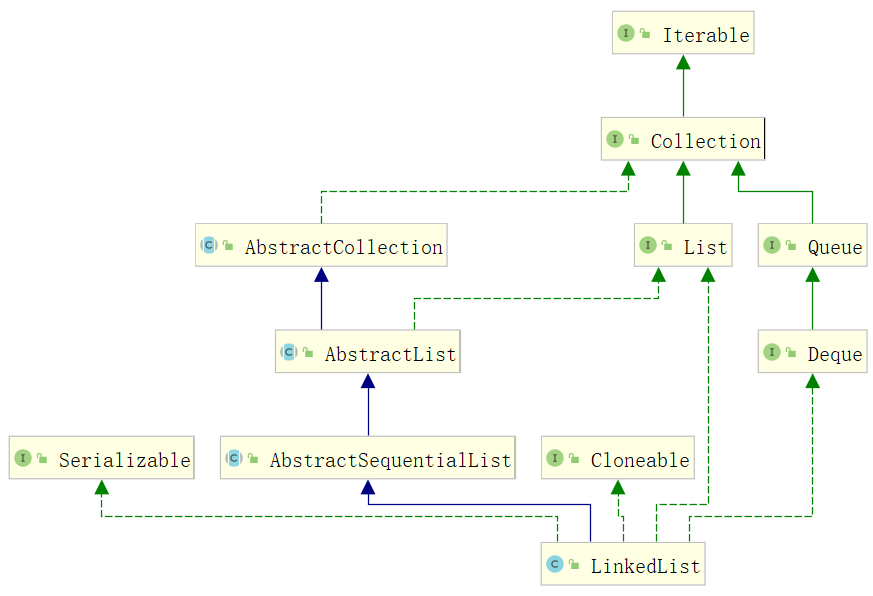1、简介
LinkedList实现接口如图所示,支持高效删除和插入操作,由于实现了Deque接口,使得LinkedList类也具有队列的特性。LinkedList不是线程安全的,如果想保证线程安全,可以使用Collections类的synchronizedList方法:
List list = Collections.synchronizedList(new LinkedList(……));
2、源码分析
2.1 内部结构
内部私有类Node
private static class Node<E> {
E item;//节点值
Node<E> next;//后继节点
Node<E> prev;//前驱节点
Node(Node<E> prev, E element, Node<E> next) {
this.item = element;
this.next = next;
this.prev = prev;
}
}2.2 构造方法
空构造方法
public LinkedList() {
}用已有的集合创建链表的构造方法
public LinkedList(Collection<? extends E> c) {
this();
addAll(c);
}2.3 add方法
add(E e)方法:将元素添加到链表尾部
public boolean add(E e) {
linkLast(e);//这里就只调用了这一个方法
return true;
} /**
* 链接使e作为最后一个元素。
*/
void linkLast(E e) {
final Node<E> l = last;
final Node<E> newNode = new Node<>(l, e, null);
last = newNode;//新建节点
if (l == null)
first = newNode;
else
l.next = newNode;//指向后继元素也就是指向下一个元素
size++;
modCount++;
}
add(int index,E e):在指定位置添加元素
public void add(int index, E element) {
checkPositionIndex(index); //检查索引是否处于[0-size]之间
if (index == size)//添加在链表尾部
linkLast(element);
else//添加在链表中间
//node(index)去寻找index对应的节点
linkBefore(element, node(index));
}addAll(Collection c):将集合插入到链表尾部
public boolean addAll(Collection<? extends E> c) {
return addAll(size, c);
}addAll(int index,Collection c):将集合从指定位置开始插入
public boolean addAll(int index, Collection<? extends E> c) {
//1:检查index范围是否在size之内
checkPositionIndex(index);
//2:toArray()方法把集合的数据存到对象数组中
Object[] a = c.toArray();
int numNew = a.length;
if (numNew == 0)
return false;
//3:得到插入位置的前驱节点和后继节点
Node<E> pred, succ;
//如果插入位置为尾部,前驱节点为last,后继节点为null
if (index == size) {
succ = null;
pred = last;
}
//否则,调用node()方法得到后继节点,再得到前驱节点
else {
succ = node(index);
pred = succ.prev;
}
// 4:遍历数据将数据插入
for (Object o : a) {
@SuppressWarnings("unchecked") E e = (E) o;
//创建新节点
Node<E> newNode = new Node<>(pred, e, null);
//如果插入位置在链表头部
if (pred == null)
first = newNode;
else
pred.next = newNode;
pred = newNode;
}
//如果插入位置在尾部,重置last节点
if (succ == null) {
last = pred;
}
//否则,将插入的链表与先前链表连接起来
else {
pred.next = succ;
succ.prev = pred;
}
size += numNew;
modCount++;
return true;
}
addFirst(E e):将元素添加到链表头部
public void addFirst(E e) {
linkFirst(e);
}
private void linkFirst(E e) {
final Node<E> f = first;
final Node<E> newNode = new Node<>(null, e, f);//新建节点,以头节点为后继节点
first = newNode;
//如果链表为空,last节点也指向该节点
if (f == null)
last = newNode;
//否则,将头节点的前驱指针指向新节点,也就是指向前一个元素
else
f.prev = newNode;
size++;
modCount++;
}
2.4 其他操作
get(int index):根据指定索引返回数据
public E get(int index) {
//检查index范围是否在size之内
checkElementIndex(index);
//调用Node(index)去找到index对应的node然后返回它的值
return node(index).item;
}
获取头节点(index=0)数据方法:
public E getFirst() {
final Node<E> f = first;
if (f == null)
throw new NoSuchElementException();
return f.item;
}
public E element() {
return getFirst();
}
public E peek() {
final Node<E> f = first;
return (f == null) ? null : f.item;
}
public E peekFirst() {
final Node<E> f = first;
return (f == null) ? null : f.item;
}
区别:getFirst()、element()、peek()、peekFirst()这四个获取头节点方法的区别为对链表为空时的处理,是抛出异常还是返回null,其中getFirst()和element()方法将会在链表为空时,抛出异常。
element()方法内部是使用getFirst()实现的,链表为空时,抛出NoSuchElementException
getLast() 方法在链表为空时,会抛出NoSuchElementException,而peekLast() 则不会,只是会返回 null。
removeLast()在链表为空时将抛出NoSuchElementException,而pollLast()方法返回null。
本博客所有文章除特别声明外,均采用 CC BY-SA 3.0协议 。转载请注明出处!